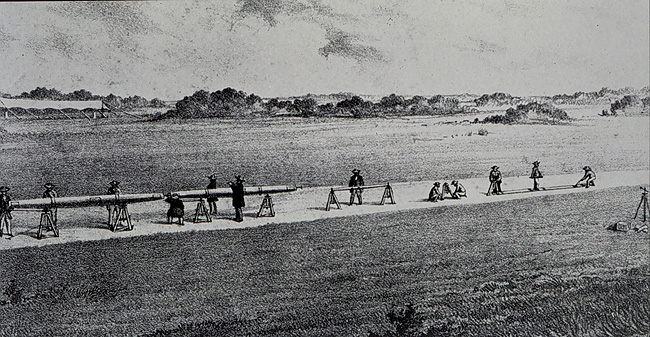 Great Theodolite
Great Theodolite The Bache- Wurdemann Compensating Device
The Bache- Wurdemann Compensating Device Eimbeck Duplex Bars
Eimbeck Duplex Bars Iced Bar B 17
Iced Bar B 17 Steel Tape with Tape Stretcher
Steel Tape with Tape Stretcher Invar Tape
Invar Tape AGA Geodimeter NASM-2A
AGA Geodimeter NASM-2A Tellurometer Model M/RA 1
Tellurometer Model M/RA 1 Laser Signal and Prismatic Mirror Reflecting System
Laser Signal and Prismatic Mirror Reflecting System AGA Geodimeters, Models 4D and 4L
AGA Geodimeters, Models 4D and 4L Big Red
Big Red AGA Geodimeter Model 6
AGA Geodimeter Model 6 Hewlett-Packard Model 3800B Distance Meter
Hewlett-Packard Model 3800B Distance Meter Tellurometer Model MA-100
Tellurometer Model MA-100 Ranger III and Rangemaster III
Ranger III and Rangemaster III Topcon ET-1 Total Station
Topcon ET-1 Total Station Trimble GPS Antenna
Trimble GPS Antenna
The Bache-Wurdemann Compensating Device
This illustration, drawn in 1854, shows a Coast Survey party measuring a base line in Key Largo, Florida.The party is using an apparatus called the Bache-Wurdemann device.This device, which was essentially two bars encased in aluminum, was designed to help reduce errors caused by the expansion and contraction of metal rods during measurements.

The accuracy of the measurement depended in part on the crew's meticulous care as they moved the Bache-Wurdemann device forward along a line that had been cleared and leveled.
By the time A. D. Bache, a great-grandson of Benjamin Franklin, was appointed Superintendent of the Coast Survey in 1843, various methods had been investigated to get around the problem caused by thermal expansion of metal at different rates. To combat this problem, Bache designed and William Wurdemann, a master mechanic in the Coast Survey, constructed the Bache-Wurdemann compensating device.
The Bache-Wurdemann compensating device was a base line apparatus composed of two bars, one of iron and one of brass, solidly connected at one end so that any temperature-related changes would be forced in one direction. Each of the two six-meter sections of bars was encased in aluminum tubes. When placed together, the bars met at a blunt knife edge and a polished agate plate. A complicated system of rollers, mirrors, microscopes, thermometers, and leveling techniques allowed any change in a bar to be precisely measured and compensated for throughout the measurements.
The accuracy of the measurement also depended on the crew's meticulous care as they moved the Bache-Wurdemann device forward. The whole assemblage progressed across specially built supports and stone monuments along a cleared and leveled line. Typically, the party moved at a rate of less than a mile a day—and use of the device was considered a great advance in cost and time savings!
Highly accurate distances were measured using the Bache-Wurdemann device in places like Florida, despite obstacles such as tangled mangrove swamps and suffocating heat.
Historical Reference
During the 1800s, distance measurements were typically done using metal rods. The biggest drawback to using metal rods was that different metals conduct heat differently, so they expand and contract at different rates. Any error caused by temperature changes would repeat multiple times throughout a survey, resulting in a significantly large error by the end of the measurement. Distance measurements were far too costly and time consuming to allow for repeat observations to compensate for temperature variations.
Bache designed and Wurdemann built the compensating device, which was used until 1873. Seven principal base lines were measured using the Bache-Wurdemann equipment, the last being in Georgia.
- Distance Measurement Instrument Shown: Bache-Wurdemann device
- Location: Key Largo base, Florida
- Manufacture Date: Approx. 1847
- Dates of Use: Mid-1800s
- Photo Date: 1854
Works Consulted
Hunt, Lt. E. B. (1855). Description of United States Coast Survey apparatus for measuring base lines. [Electronic version]. Report of the Superintendent of the Coast Survey Showing the Progress of the Survey During the Year 1854, p. 103-108.
Williamson, R. O. (1957). Base Line Measuring Devices. Unpublished paper. Report of the Secretary of the Treasury Communicating a Report of the Superintendent of the Coast Survey, Showing the Progress of that Work During the Year Ending November, 1847. p. 39-42.
Related Web Sites
